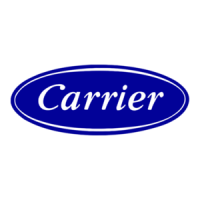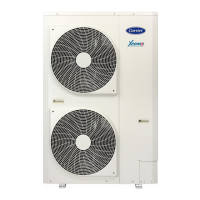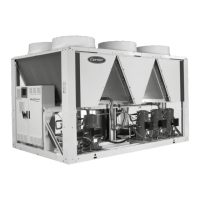70
CARRIER COMFORT NETWORK
®
(CCN) COMMUNICA-
TION BUS WIRING — The communication bus wiring is a
shielded, 3-conductor cable with drain wire and is field sup-
plied and installed in the field.
The system elements are connected to the communication
bus in a daisy chain arrangement. The positive pin of each
system element communication connector must be wired to the
positive pins of the system elements on either side of it. This is
also required for the negative and signal ground pins of
each system element. Wiring connections for CCN should be
made at TB 3 (terminal block). Consult the CCN Contractor’s
Manual for further information. See Fig. 62.
NOTE: Conductors and drain wire must be 20 AWG
(American Wire Gage) minimum stranded, tinned copper.
Individual conductors must be insulated with PVC, PVC/
nylon, vinyl, Teflon*, or polyethylene. An aluminum/polyester
100% foil shield and an outer jacket of PVC, PVC/nylon,
chrome vinyl, or Teflon with a minimum operating tempera-
ture range of –4 F (–20 C) to 140 F (60 C) is required. Refer to
Table 15 for a list of manufacturers that produce CCN bus wir-
ing that meets these requirements.
Table 15 — CCN Communication Bus Wiring
It is important when connecting to a CCN communication
bus that a color coding scheme be used for the entire network
to simplify the installation. It is recommended that red be used
for the signal positive, black for the signal negative, and white
for the signal ground. Use a similar scheme for cables contain-
ing different colored wires. At each system element, the shields
of its communication bus cables must be tied together. If the
communication bus is entirely within one building, the result-
ing continuous shield must be connected to a ground at one
point only. If the communication bus cable exits from one
building and enters another, the shields must be connected to
grounds at the lightning suppressor in each building where the
cable enters or exits the building (one point per building only).
To connect the unit to the network:
1. Turn off power to the control box.
2. Cut the CCN wire and strip the ends of the red (+), white
(ground), and black (–) conductors. Substitute appropri-
ate colors for different colored cables.
3. Connect the red wire to (+) terminal on TB3 of the plug,
the white wire to COM terminal, and the black wire to the
(–) terminal.
4. The RJ14 CCN connector on TB3 can also be used, but is
only intended for temporary connection (for example, a
laptop computer running Service Tool).
NON-CCN COMMUNICATION WIRING — The 30RB units
offer several non-CCN translators. Refer to the separate instal-
lation instructions for additional wiring steps.
Step 7 — Install Accessories — A number of
accessories are available to provide the following optional fea-
tures (for details, refer to the Controls, Start-Up, Operation,
Service and Troubleshooting guide).
Energy management module is used for any of the follow-
ing types of temperature reset, demand limit and ice features:
• 4 to 20 mA inputs for cooling set point reset and capacity
limit (requires field-supplied 4 to 20 mA generator)
• 0 to 10 v output for percentage total capacity running
• 24 v discrete outputs for shutdown and running relays
• 10k space temperature input
• Discrete inputs for occupancy override, demand limit
switch 2 (step 1 demand limit is wired to the base board,
requires field-supplied dry contacts), remote lockout
switch and ice done switch (requires field-supplied dry
contacts)
NAVIGATOR™ DISPLAY — The Navigator display pro-
vides hand-held, mobile capability using easy to read 4-line
display. Keypad function is the same as the scrolling marquee
display. The Navigator display features a mounting magnet for
‘hands free’ service of components.
REMOTE ENHANCED DISPLAY — For applications
where remote monitoring of the equipment is required, the
remote enhanced display provides an indoor display capable of
monitoring any equipment on the Carrier Comfort Network
®
(CCN) bus. A CCN bus is needed.
LOW AMBIENT TEMPERATURE OPERATION — If
outdoor ambient operating temperatures below 32 F (0° C) are
expected, refer to separate installation instructions for low
ambient temperature operation using the low ambient tempera-
ture head pressure control accessory.
MINIMUM LOAD ACCESSORY — If minimum load acces-
sory is required, contact your local Carrier representative for
more details. For installation details, refer to separate installa-
tion instructions supplied with the accessory package.
* Registered trademark of DuPont.
MANUFACTURER
PART NUMBER
Regular Wiring Plenum Wiring
Alpha 1895 —
American A21451 A48301
Belden 8205 884421
Columbia D6451 —
Manhatten M13402 M64430
Quabik 6130 —
IMPORTANT: A shorted CCN bus cable will prevent
some routines from running and may prevent the unit
from starting. If abnormal conditions occur, disconnect
the machine from the CCN network. If conditions
return to normal, check the CCN connector and cable.
Run new cable if necessary. A short in one section of
the bus can cause problems with all system elements
on the bus.
(+) (COM) (-) SHIELD
CCN
RED
WHT
BLK
CCNLEN
(+) (COM) (-) SHIELD
CCN
RED
WHT
BLK
CCNLEN
TO NEXT
DEVICE
(+) (COM) (-) SHIELD
CCN
RED
WHT
BLK
CCN
LEN
SHIELD
LEGEND
Fig. 62 — TB-3 — CCN Wiring
CCN — Carrier Comfort Network®
LEN — Local Equipment Network
TB3
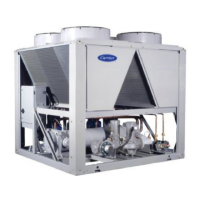
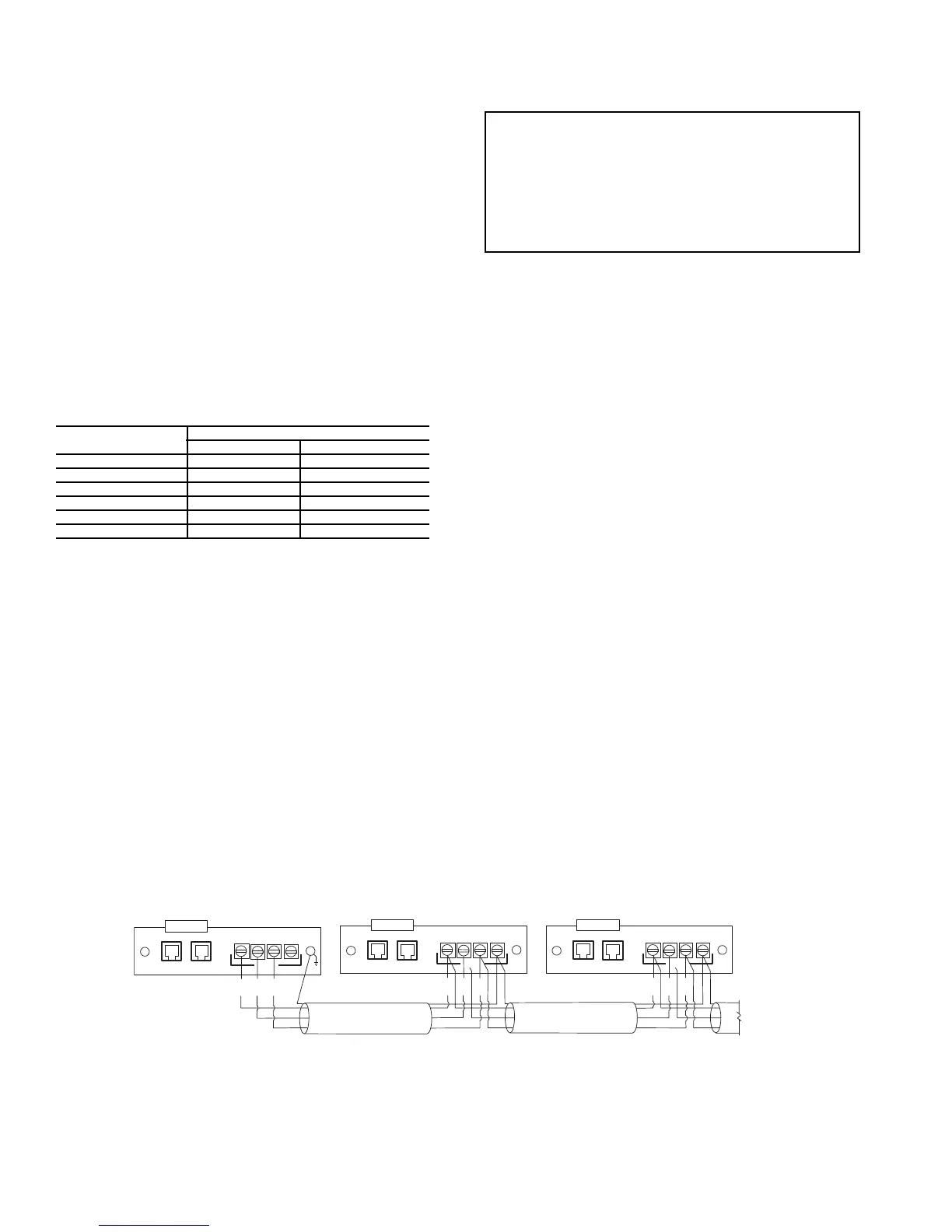